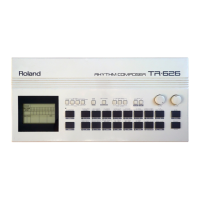MIDI Function
2.
Altering a MIDI Function Setting
This
section explains how to
set
the
MIDI
function for the most
commonly used connections.
a.
When
the
TR-626
1s
to
be used
as
a MIDI sound source
Step
1
The
drum
voices of
the
TR-626
can be made to
sound
when
rhythm
pattern
data
is supplied from
external
devices,
such
as
other
rhythm
machines, keyboards, sequencers, etc.,
that
have
MIDI
terminals.
In
an
instance
such
as
this,
the
rhythm
pattern
data
does
not
need to be
written
into the
TR-626's
memory.
MIDI
I t
OUT
IN
Sequencer
TR-626
MC-500
Change
either
the
transmitter's
transmission
channel
or
the
TR-626'
s
reception
channel
to
set
them
to
the
same
MIDI
channel.
(Refer
to
"o
Altering
the
reception
channel"
on
p.83.)
* If
the
TR-626
is
the
only
receiving
device,
step
1
can
be
dispensed
with.
Simply
turn
the
OMNI
mode
on,
instead
of
off,
in
step
2.
* Changing
the
transmission channel
of
the transmitter
(s)
should be done
strictly
in
accordance
with
the
instructions
in
the
operation manual for
the
transmitter
.(s).
(Transmission/Reception Channel)
Step 2
There
are 16
MIDI
channels.
The
transmission channel,
the
channel for
transmitting
information,
can
be designated as
any
of Channels 1 to
16. Since this is so, when information
about
several channels
is
sent
through
a single
MIDI
cable, the
TR-626
will receive only the
information
sent
on
the
reception channel designated.
Turn
the
TR-626's
OMNI
mode off. (See "Altering
OMNI
mode"
on
p.83.)
79

